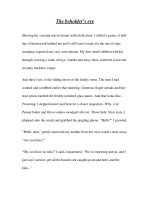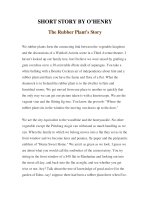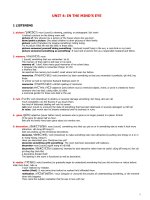dk eye wonder plant
Bạn đang xem bản rút gọn của tài liệu. Xem và tải ngay bản đầy đủ của tài liệu tại đây (10.2 MB, 49 trang )
Eye Wonder
First published in Great Britain in 2005 by
Dorling Kindersley Limited
80 Strand, London WC2R 0RL
A Penguin Company
2 4 6 8 10 9 7 5 3 1
Copyright © 2005 Dorling Kindersley Limited, London
A CIP catalogue record for this book
is available from the British Library.
All rights reserved. No part of this publication may be
reproduced, stored in a retrieval system, or transmitted in
any form or by any means, electronic, mechanical,
photocopying, recording, or otherwise, without the prior
written permission of the copyright owner.
ISBN 1-4053-0598-3
Colour reproduction by Colourscan, Singapore
Printed and bound in Italy by L.E.G.O.
see our complete
catalogue at
www.dk.com
Written and edited by Fleur Star
Designed by Janet Allis
Publishing manager Sue Leonard
Managing art editor Clare Shedden
Jacket design Chris Drew
Picture researcher Sarah Pownall
Production Luca Bazzoli
DTP Designer Almudena Díaz
Consultant Sandra Bell
LONDON, NEW YORK, MUNICH,
MELBOURNE, and DELHI
4-5
What is a plant?
6-7
Grow up!
8-9
Putting down roots
10-11
Leaf it out
12-13
Food factories
14-15
Pollination
16-17
Flower partners
18-19
Going to seed
20-21
Carried away
22-23
On the menu
24-25
Plant protection
26-27
Tree types
Contents
28-29
Tree house
30-31
Muscling in
32-33
Meat-eaters
34-35
Creepers and climbers
36-37
Water worlds
38-39
On dry land
40-41
Cold climate
42-43
Plant providers
44-45
Strange but true
46-47
Glossary
48
Index and
acknowledgements
4
Life on Earth is divided into
plants, animals, and fungi.
There are thought to be
about 400,000 species of
plants in the world. The first
plants – algae, which live
in water – appeared about
3 billion years ago.
Plant parts
Every part of a plant has
a job to do. Leaves make
food, the stem carries
water, and flowers make
seeds. All flowering
plants have
the same basic
make-up, even
if they look
quite different.
What is a plant?
Flower
Flower bud
Leaf bud
Roots
Plant needs
A plant needs four things to survive: sunlight,
water, minerals, and air. Minerals come from
the soil, while air provides the gases for
breathing and photosynthesis (making food).
Woody
stem
Leaf
Roots divide to
hold the plant
in the ground.
Stalk
Hibiscus plant
Sunlight
Water
Minerals from soil
Air
Anthers
Is it a plant?
Lichen, seen here growing on
rotten trees, is a partnership of
algae and fungi. Unlike algae,
lichen and fungi are not
plants because they do
not make their own food
through photosynthesis.
First plants
Non-flowering plants, such as
ferns and mosses, are among
the oldest plants in the
world. About 300 million
years ago great forests of
them covered the land.
Ferns and mosses
do not have seeds,
but reproduce
from spores.
First flowers
Ancient fossils show that some
of the first flowers looked very
much like magnolias. They
share features that not all
plants have, such as having
many anthers.
Lichen growing
on trees is
usually grey,
green, or yellow.
Grow up!
Germinate When a seed
starts growing into a plant.
Root The part of a plant
that grows underground and
absorbs water and nutrients.
Shoot Any part of a plant
that grows above ground,
such as the stem or leaves.
Plant words
Inside story
To start growing, a seed
needs air, water, and
the right temperature.
The seed absorbs air and
water, which makes it
swell and split. Then the
first root breaks through.
The first shoot is
made up of the
leaves and stem.
A seed is a pocket-sized plant. It contains everything that
a plant has: leaves, stems, and roots, plus food, or nutrients,
for the time the plant is inside the seed. Some seeds can lie
around for years waiting for the right conditions to grow.
6
Root
Reach for the Sun
As soon as the leaves are out, they
begin to catch sunlight to make
food. Now the plant has grown,
the seed will shrivel because it
is no longer needed.
Cracking up
Young plants are
surprisingly strong. They
can force their way up through
rocks, tarmac and cracks in the
pavement. You might be able
to find some growing through
your garden path!
Roots keep the
plant fixed firmly
in the ground.
Taking root
Roots spread out
underground to absorb
water and nutrients
from the earth. They
are covered in hairs
to take in as much
water as possible.
7
8
Roots do two things: they anchor plants and keep
them secure, and they absorb water and food. Some
roots have weird and wonderful ways of doing this!
Putting down roots
Far out
Roots can only grow
where there is water.
Tree roots near the
surface grow outwards,
up to four times the
width of the tree.
Other roots can dig
down deep enough to
break through sewers.
Storage system
Not everything underground is
a root. Bulbs are food storage
systems that contain the
leaves and stems of new
plants. When the plant
grows, the roots descend.
Stuck in the mud
Mangroves live in swamps. Their
huge prop roots support the stems
to stop them being washed away.
The tangled roots also trap mud,
which has nutrients for the tree.
9
Big butts
When trees grow in
shallow soil, such as
in rainforests, their roots
might grow above the
surface of the ground.
These are buttress roots,
which keep the tree
stable. Some can
grow to 4.5 m
(15 ft) tall.
GRASS ROOTS
In 1937, an American scientist called Howard Dittmer
studied the roots of a rye grass plant. The plant was just
50 cm (20 in) tall, and had 80 shoots. But it
had more than 620 km (380 miles) of roots!
They could cover an area of 237 sq m
(2,554 sq ft), enough to carpet
a large house. And this
doesn’t include the
14 billion root hairs!
All leaves are made up of a blade on a stalk, but
each different kind has it own shape, colour, and
way of growing. This is because plants have leaves
that suit the environment in which they grow.
Leaf it out
•
Cactus plants have spines
instead of leaves.
•
Leaves are covered in wax
to stop them drying out in the
sunlight and wind.
•
Tea is made from the leaves
of the tea plant. 500 g (1 lb) of
tea leaves can make 300 cups.
Leaf facts
Leaf types
Most plants have simple
leaves, which means they
have a single blade coming
off the stalk. Each leaf grows
from a bud. Other plants
have compound leaves, made
up of individual leaflets.
Midrib
Palmate leaves look
like hands. They
can be simple or
compound, like this
horse chestnut.
Many pine trees grow in
cold places. Their needles
are thin and pointed to
shake off snow.
A variegated leaf has spots
of different colours, which
come from chemicals
inside the leaf.
V
a
r
i
e
g
a
t
e
d
N
e
e
d
l
e
s
P
a
l
m
a
t
e
S
i
m
p
l
e
Vein
Stalk
Leaf blade
10
The “leaves” of wild
asparagus are really
feathery stems that
can stand up to gales.
What a drip
Leaves cannot absorb water,
so they have drainage systems
to stop them drowning. Water
collects in ridges and runs off a
“drip-tip” on the end of the leaf.
Changing colour
Leaves get their green
colour from chlorophyll,
which they use to make
food. When the leaves
rest in the autumn, the
chlorophyll fades away,
revealing the reds
and yellows of other
chemicals in the leaf.
The leaflets of a compound
leaf grow straight from the
stalk, not from buds.
C
o
m
p
o
u
n
d
F
e
a
t
h
e
r
y
Some leaves
turn red from
waste products
stored inside.
11
Drip-tip
Plants are unique – they are the only living
things that make their own food. This process is
called photosynthesis, which can only happen in
the daytime because it uses sunlight.
Food factories
What’s cooking?
Leaves take in sunlight, carbon
dioxide (CO
2
) from the air, and
water from the roots and mix
them together using chlorophyll.
This recipe makes glucose,
a type of sugary plant food,
and oxygen.
Plants lose
water and
gases from
their leaves.
Sunlight
Going green
This close-up of a leaf shows
green dots inside the cells.
These are the stores of
chlorophyll, and they give
leaves their green colour.
Air holes
The carbon dioxide used
in photosynthesis is taken
in through stomata, tiny
holes on the surface of
every leaf. They also
“breathe out” any extra
oxygen that the plant does
not use for respiration.
C
a
r
b
o
n
d
i
o
x
i
d
e
O
x
y
g
e
n
O
p
e
n
s
t
o
m
a
t
a
Photosynthesis The unique
way plants make their
own food.
Respiration How living
things turn food into energy.
Chlorophyll A chemical
found inside leaves that is
used for photosynthesis.
Leaf words
13
Spare CO
2
that
has not been used
for making food
is released back
into the air.
Energy source
Like all living things, plants
get energy from food. This is
called respiration. Plants use
oxygen to turn food into
energy, which helps them
to grow. The oxygen
comes from the air or
from photosynthesis.
Closed for the night
Respiration occurs 24 hours
a day, but photosynthesis
stops at night when there is
no sun. Many plants close
their stomata at night as
they rest. Oxygen and CO
2
can still pass in and out of
the leaf cells even though
the stomata are shut.
W
a
t
e
r
O
x
y
g
e
n
C
a
r
b
o
n
d
i
o
x
i
d
e
C
l
o
s
e
d
s
t
o
m
a
t
a
Watch a patch of flowers on a
summer’s day and you will soon see
a bee or a butterfly. Many flowers
need these insects for pollination (the
transfer of pollen from plant to plant).
Pollination
Landing lights
This flower looks plain yellow to us,
but insects can see ultra-violet light.
This shows up patterns on flowers
called nectar guides. They point out
exactly where the nectar is in the
flower, leading insects straight to it.
Ovary
Anther
Stigma
•
A honeybee may visit
10,000 flowers in one day.
•
Bees account for 80 per
cent of all insect pollination.
•
Some plants rely on the
same insect for pollination,
others may be pollinated by
several different insects.
Pollination facts
Take a close look
Pollination happens when pollen from
one plant’s anthers is carried to the
stigma of another. The pollen then
fertilizes an egg in the ovary,
the first step to making a seed.
Style
Normal light
Ultra-violet light
Anther
Petal
Busy as a bee
Bees pollinate many of the
world’s crops, from apples
and pears to cucumbers and
melons. They zip between
the flowers at the dizzy
speed of 24 kph (15 mph).
A good dusting
When a bee lands on
a flower, its body is
dusted with pollen. It
collects this pollen in
pollen baskets on its
back legs, but enough
is left to pollinate
other flowers.
The bee uses its
proboscis to suck up
nectar to take back
to the hive.
Pollen
Magnified many times, pollen
grains are differently shaped
depending on their parent plant.
Some have spiky casings.
The bee mixes pollen
with nectar, making
it sticky so it stays in
the pollen baskets.
15
•
A carpenter bee buzzes at
the right pitch to shake loose
the pollen of a gentian flower.
•
The dead-horse arum stinks
of rotting meat to attract
blow-flies.
•
Moths seek pale yellow
or white flowers at night.
Perfect pairs
Just like you might prefer one drink
to another, some animals will choose to
drink nectar from certain plants. And
these plants will try all sorts of tricks
to attract their chosen pollinator.
Flower partners
Going batty
In the deserts of North America,
long-nosed bats feed from century
plants. The bat’s thick fur picks up
lots of pollen as it buries its head
in the flower for a drink of nectar.
Fly-by feeder
Hummingbirds can access flowers that other birds
cannot reach, because they are the only birds
that can hover in mid-air. Flowers that want
to attract birds are usually coloured red.
Bee mine
Bee orchids look and
smell like female bees
to attract male bees.
There are around 130
types of bee orchid in
Europe that impersonate
different kinds of bees.
Smelling
right is as
important as
looking pretty.
16
Lap it up
In New Zealand, flax plants provide a
tasty drink for geckos. As they climb up
the stem and drink from the flower, they
get pollen all over their chins.
Running wild
Tiny honey possums in
Australia clamber all over
the flowers of a banksia
plant to gather nectar.
Of course, they get covered
in pollen while doing so!
The yellow
pollen stains
the gecko’s chin.
17
Flowering plants reproduce by making
seeds, which happens after a plant has
been pollinated. Seeds are valuable and
need protecting, so a plant will grow
fruit to cover the seeds.
From blossom to apple
An apple tree’s white blossom
appears in the spring.
When the blossom is
pollinated, it makes
seeds. Then an apple
grows from each blossom
to protect the seeds.
By autumn, the apple
is fully grown and
ready to eat!
Going to seed
Seed head
A sunflower is made
up of lots of little flowers,
each of which make a seed
when it is pollinated. There are
around 1,000 seeds inside just
one sunflower head. Every seed
is surrounded by its own case.
Sunflower seeds
can be roasted
and eaten
in salads.
18
Seeds
Seeds
Scores of spores
Non-flowering plants do
not have seeds. Ferns have
spores instead, which can
be seen on the underside of
the leaves. When the spores
are ripe, they fall off the leaf.
Wooden fruit
Not all fruit is edible: the fruit of pine
trees are wooden cones. Pine trees
take two years to make seeds, which
are kept safe inside the cones. When
the seeds are ready, the cones burst
open. The seeds fall to the ground,
where many will be eaten by forest
animals and birds.
Spores on
underside of
a fern leaf.
Sprouting spuds
Have you ever seen an
old, wrinkly potato?
It probably has “eyes” –
green buds that will grow
into new plants. Potatoes
are not seeds, but tubers,
which are underground
food stores for the plant.
Strawberries have seeds,
but new plants grow more
easily from runners.
New potato plants sprouting.
19
Seeds
20
Plants spread their seeds so they can grow
in new places. This is called seed dispersal.
It gives the seeds a chance to find sunlight,
water, and food that are not already being
used by the parent plant or by other seeds.
Carried away
Get stuck in
Have you ever let a pet dog run in
fields? It might have come back with
burrs in its fur. Burrs are seeds with
sticky or spiky coats that grip animal
fur, later falling off onto new ground.
SPIT OUT THE SEEDS
The Mediterranean squirting cucumber
has a messy method of seed dispersal.
As it grows, each cucumber fruit fills with
slime until there’s no more room. Then,
suddenly POP! The fruit bursts, comes
off its stalk, and flies through the air
like a rocket for 6 m
(20 ft), spraying
slime and seeds
behind it.
Just passing through
Fruit is tasty and colourful to get
animals to eat it. Animals
swallow seeds with the
fruit. When the seeds
have passed through
the animal, they are
far away from the
parent plant.
A flying start
Impatiens are a group of garden
plants sometimes called “touch-
me-nots”. Their seed pods are
ready to burst at the slightest
touch. Seeds are flung out,
although they don’t
travel far.
The pod pushes
the seeds forward.
Go with the flow
Coconuts may be one of the
largest seeds, but they are
hollow and light enough to
float. This way they can travel
across oceans, and they have
been known to survive journeys
of 1,600 km (1,000 miles).
Propeller powered
Sycamore seeds are among
the heaviest to ride on the
wind. Their shape works
like a helicopter rotor,
spinning round in the breeze
so the seeds travel further.
T
h
e
w
i
n
d
w
i
l
l
c
a
r
r
y
t
h
e
s
e
s
e
e
d
s
f
o
r
m
a
n
y
k
i
l
o
m
e
t
r
e
s
.
Blowing in the wind
A dandelion seed is so light
it can be blown away by the
wind, carried on its own fluffy
white parachute. A dandelion
is not one flower, but is made
up of florets that each make
a seed when pollinated. One
plant can make up to 500 seeds.
All life on Earth depends on plants.
Even those animals that just eat
meat, eat other animals who feed
on plants. People have been growing
plants for food for thousands of years.
On the menu
A cereal success story
Wheat is the world’s most widely-grown plant,
found on every continent except Antarctica.
It is a type of grass called a cereal, which
means it has seeds that can be made into flour.
This group also includes oats, maize, and rice.
Sweet seeds
Chocolate is made from
the seeds of a cocoa tree.
The white seeds inside the
pods are dried and ground
into cocoa powder, which
actually tastes quite bitter.
Herbs and spices
A herb is any plant with a non-
woody stem, but what cooks call
herbs are leaves or flowers of
certain, safe-to-eat plants.
Spices, such as pepper,
are made from ground
seeds or bark.
Spoilt for choice
A vegetable is a plant or part
of a plant that is grown to
be eaten. This includes
fruit, seeds, roots, and
leaves, such as beans
(seeds) and carrots
(roots). But there
is no one plant
that we can eat
every part of.
23
Sharp taste
Ants live inside the thorns of acacia
trees, safe from predators. In return,
they protect the tree by biting the
tongues of animals eating the tree.
The tree’s spiky thorns do
not stop the giraffe from
having a good chew.
Plants have many ways to defend themselves from being
trampled or eaten. Some have built-in protection, such as
thorns. Other plants might form a partnership with animals.
They can’t run away from predators!
Plant protection









